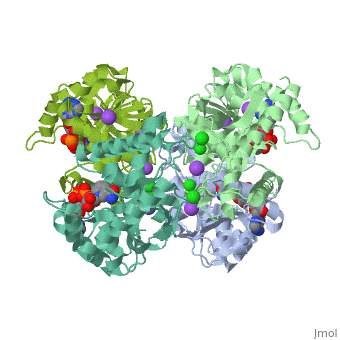2x0r: Difference between revisions
No edit summary |
No edit summary |
||
| Line 3: | Line 3: | ||
<StructureSection load='2x0r' size='340' side='right'caption='[[2x0r]], [[Resolution|resolution]] 2.92Å' scene=''> | <StructureSection load='2x0r' size='340' side='right'caption='[[2x0r]], [[Resolution|resolution]] 2.92Å' scene=''> | ||
== Structural highlights == | == Structural highlights == | ||
<table><tr><td colspan='2'>[[2x0r]] is a 2 chain structure with sequence from [ | <table><tr><td colspan='2'>[[2x0r]] is a 2 chain structure with sequence from [https://en.wikipedia.org/wiki/"flavobacterium_(halobacterium)_maris-mortui_(sic)"_elazari-volcani_1940 "flavobacterium (halobacterium) maris-mortui (sic)" elazari-volcani 1940]. This structure supersedes the now removed PDB entry [http://oca.weizmann.ac.il/oca-bin/send-pdb?obs=1&id=1gt2 1gt2]. Full crystallographic information is available from [http://oca.weizmann.ac.il/oca-bin/ocashort?id=2X0R OCA]. For a <b>guided tour on the structure components</b> use [https://proteopedia.org/fgij/fg.htm?mol=2X0R FirstGlance]. <br> | ||
</td></tr><tr id='ligand'><td class="sblockLbl"><b>[[Ligand|Ligands:]]</b></td><td class="sblockDat"><scene name='pdbligand=CL:CHLORIDE+ION'>CL</scene>, <scene name='pdbligand=NA:SODIUM+ION'>NA</scene>, <scene name='pdbligand=NAD:NICOTINAMIDE-ADENINE-DINUCLEOTIDE'>NAD</scene></td></tr> | </td></tr><tr id='ligand'><td class="sblockLbl"><b>[[Ligand|Ligands:]]</b></td><td class="sblockDat" id="ligandDat"><scene name='pdbligand=CL:CHLORIDE+ION'>CL</scene>, <scene name='pdbligand=NA:SODIUM+ION'>NA</scene>, <scene name='pdbligand=NAD:NICOTINAMIDE-ADENINE-DINUCLEOTIDE'>NAD</scene></td></tr> | ||
<tr id='related'><td class="sblockLbl"><b>[[Related_structure|Related:]]</b></td><td class="sblockDat">[[2j5r|2j5r]], [[2j5k|2j5k]], [[1d3a|1d3a]], [[2j5q|2j5q]], [[2hlp|2hlp]], [[1hlp|1hlp]], [[1o6z|1o6z]]</td></tr> | <tr id='related'><td class="sblockLbl"><b>[[Related_structure|Related:]]</b></td><td class="sblockDat"><div style='overflow: auto; max-height: 3em;'>[[2j5r|2j5r]], [[2j5k|2j5k]], [[1d3a|1d3a]], [[2j5q|2j5q]], [[2hlp|2hlp]], [[1hlp|1hlp]], [[1o6z|1o6z]]</div></td></tr> | ||
<tr id='activity'><td class="sblockLbl"><b>Activity:</b></td><td class="sblockDat"><span class='plainlinks'>[ | <tr id='activity'><td class="sblockLbl"><b>Activity:</b></td><td class="sblockDat"><span class='plainlinks'>[https://en.wikipedia.org/wiki/Malate_dehydrogenase Malate dehydrogenase], with EC number [https://www.brenda-enzymes.info/php/result_flat.php4?ecno=1.1.1.37 1.1.1.37] </span></td></tr> | ||
<tr id='resources'><td class="sblockLbl"><b>Resources:</b></td><td class="sblockDat"><span class='plainlinks'>[ | <tr id='resources'><td class="sblockLbl"><b>Resources:</b></td><td class="sblockDat"><span class='plainlinks'>[https://proteopedia.org/fgij/fg.htm?mol=2x0r FirstGlance], [http://oca.weizmann.ac.il/oca-bin/ocaids?id=2x0r OCA], [https://pdbe.org/2x0r PDBe], [https://www.rcsb.org/pdb/explore.do?structureId=2x0r RCSB], [https://www.ebi.ac.uk/pdbsum/2x0r PDBsum], [https://prosat.h-its.org/prosat/prosatexe?pdbcode=2x0r ProSAT]</span></td></tr> | ||
</table> | </table> | ||
== Function == | == Function == | ||
[[ | [[https://www.uniprot.org/uniprot/MDH_HALMA MDH_HALMA]] Catalyzes the reversible oxidation of malate to oxaloacetate.[HAMAP-Rule:MF_00487] | ||
== Evolutionary Conservation == | == Evolutionary Conservation == | ||
[[Image:Consurf_key_small.gif|200px|right]] | [[Image:Consurf_key_small.gif|200px|right]] | ||
Revision as of 19:09, 22 December 2021
R207S, R292S Mutant of Malate Dehydrogenase from the Halophilic Archeon Haloarcula marismortui (HoloForm)R207S, R292S Mutant of Malate Dehydrogenase from the Halophilic Archeon Haloarcula marismortui (HoloForm)
Structural highlights
Function[MDH_HALMA] Catalyzes the reversible oxidation of malate to oxaloacetate.[HAMAP-Rule:MF_00487] Evolutionary Conservation Check, as determined by ConSurfDB. You may read the explanation of the method and the full data available from ConSurf. Publication Abstract from PubMedThe three-dimensional crystal structure of the (R207S, R292S) mutant of malate dehydrogenase from Haloarcula marismortui was solved at 1.95A resolution in order to determine the role of salt bridges and solvent ions in halophilic adaptation and quaternary structure stability. The mutations, located at the dimer-dimer interface, disrupt two inter-dimeric salt bridge clusters that are essential for wild-type tetramer stabilisation. Previous experiments in solution, performed on the double mutant, had shown a tetrameric structure in 4M NaCl, which dissociated into active dimers in 2M NaCl. In order to establish if the active dimeric form is a product of the mutation, or if it also exists in the wild-type protein, complementary studies were performed on the wild-type enzyme by analytical centrifugation and small angle neutron scattering experiments. They showed the existence of active dimers in NaF, KF, Na(2)SO(4), even in the absence of NADH, and in the presence of NADH at concentrations of NaCl below 0.3M. The crystal structure shows a tetramer that, in the absence of the salt bridge clusters, appears to be stabilized by a network of ordered water molecules and by Cl(-) binding at the dimer-dimer interface. The double mutant and wild-type dimer folds are essentially identical (the r.m.s. deviation between equivalent C(alpha) positions is 0.39A). Chloride ions are also observed at the monomer-monomer interfaces of the mutant, contributing to the stability of each dimer against low salt dissociation. Our results support the hypothesis that extensive binding of water and salt is an important feature of adaptation to a halophilic environment. The Oligomeric states of Haloarcula marismortui malate dehydrogenase are modulated by solvent components as shown by crystallographic and biochemical studies.,Irimia A, Ebel C, Madern D, Richard SB, Cosenza LW, Zaccai G, Vellieux FM J Mol Biol. 2003 Feb 21;326(3):859-73. PMID:12581646[1] From MEDLINE®/PubMed®, a database of the U.S. National Library of Medicine. See AlsoReferences |
| ||||||||||||||||||||
